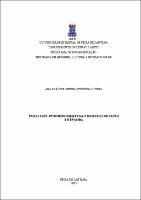| Compartilhamento |


|
Use este identificador para citar ou linkar para este item:
http://tede2.uefs.br:8080/handle/tede/1918| Tipo do documento: | Dissertação |
| Título: | Feira livre: patrimônio material e imaterial de Santo Estevão/BA |
| Autor: | Guerra, Ana Cláudia Moura Teixeira  |
| Primeiro orientador: | Azevedo, Livia Dias de |
| Resumo: | A presente pesquisa tem como objeto de estudo a feira livre de Santo Estêvão - Ba, como patrimônio material e imaterial, e discute os impactos socioeconômicos, as emoções, sensações e as memórias dessa feira livre para as pessoas da cidade. O objetivo geral é entender o que poderá fazer a feira livre da cidade de Santo Estêvão se tornar patrimônio histórico cultural material e imaterial, e como foram construídas e representadas as imagens sobre a cidade redesenhada a partir das transferências da feira, no período de 1922 a 1990. A metodologia está pautada na abordagem qualitativa, e se utiliza do método etnográfico, que possibilita analisar a história, as memórias e as sensações sobre/na feira livre da cidade. Também faz uso da pesquisa documental, quando da análise de documentos do Arquivo Público; da iconografia e da iconologia, no estudo de fotografias antigas e atuais disponíveis em revistas publicadas pela prefeitura da cidade. Como instrumento, tem-se o uso da análise da realidade. No que concerne ao referencial teórico, a pesquisa está baseada nos conceitos de desenho do espaço urbano (mapas), memória coletiva e lugares de memórias, tendo como aporte os estudos de Pesavento (2007), Pierre Nora (1993), Gilmar Arruda (2000), Jacque Le Goff (1998), Menezes (1998) e Milton Santos (1978). Sabendo que a dinâmica e resistência da feira livre de Santo Estêvão representam sua importância na vida das pessoas que dela dependem para sua subsistência, considera-se importante descrever o contexto histórico organizacional dessa feira, para saber: o que a fez para que possa se tornar um patrimônio material e imaterial para a cidade; o que a torna responsável por movimentar a economia local; como essa feira livre traz ao presente as sensibilidades do passado dessa cidade; e, ainda, ao analisar as vivências, emoções das pessoas que a frequentam, compreender de que forma o visível e o invisível da cidade convergem e divergem no comércio informal de Santo Estêvão. |
| Abstract: | The present research has as its object the street market of Santo Estêvão – BA, as a material and immaterial patrimony, and discusses the socioeconomic impacts, emotions, sensations and memories of this street market for the people of the city. This study has as general objective to understand what made the free market in the city of Santo Estêvão become a material culture and immaterial historical patrimony, and how images about the redesigned city were constructed and represented based on the transfers of the market, in the period of 1922 to 1990. And as specific objectives: to describe the scenario of the street market in Santo Estêvão based on its images; narrate the memories told by the people of Santo Esteve about this free market; identify what makes the street market recognized as material and immaterial patrimony of the aforementioned city. To this end, the methodology is based on a qualitative approach, and uses the ethnographic method, which makes it possible to analyze the history, memories and sensations about or in the city's street market. It also uses documentary research, when analyzing documents from the public archive; iconography and iconology, in the study of old and current photographs available in magazines published by the city hall. As an instrument, the use of interviews will be considered to collect data and analyze reality. Theoretically, the research is based on the concepts of urban space design (maps), collective memory and places of memories, having as theoretical support the studies of Pesavento (2007), Pierre Nora (1993), Gilmar Arruda (2000), Jacque Lê Goff (1998), Menezes (1998) and Milton Santos (1978). Knowing that the dynamics and resilience of the Santo Estêvão street market represent its importance in the lives of the people who depend on it for their subsistence, it is considered important to describe the historical organizational context of this market, to know: what made it so that it could become a material and immaterial heritage for the city; what makes it responsible for moving the local economy; how this street market brings to the present the sensibilities of the past of this city; and, also, by analyzing the experiences and emotions of the people who frequent it, understand how the visible and the invisible of the city converge and diverge in the informal commerce of Santo Estêvão. |
| Palavras-chave: | Feira livre Patrimônio material e imaterial Cultura Memória Imagem Street market Material and immaterial patrimony Culture Memory Image |
| Área(s) do CNPq: | LINGUISTICA, LETRAS E ARTES |
| Idioma: | por |
| País: | Brasil |
| Instituição: | Universidade Estadual de Feira de Santana |
| Sigla da instituição: | UEFS |
| Departamento: | DEPARTAMENTO DE LETRAS E ARTES |
| Programa: | Mestrado Acadêmico em Desenho Cultura e Interatividade |
| Citação: | GUERRA, Ana Cláudia Moura Teixeira. Feira livre: patrimônio material e imaterial de Santo Estevão/BA, 2025, 119 f., Dissertação (mestrado) - Programa de Pós-Graduação em Desenho Cultura e Interatividade, Universidade Estadual de Feira de Santana, Feira de Santana. |
| Tipo de acesso: | Acesso Aberto |
| URI: | http://tede2.uefs.br:8080/handle/tede/1918 |
| Data de defesa: | 26-Jun-2025 |
| Aparece nas coleções: | Coleção UEFS |
Arquivos associados a este item:
| Arquivo | Descrição | Tamanho | Formato | |
|---|---|---|---|---|
| ANA CLÁUDIA MOURA TEIXEIRA GUERRA - dissertacao.pdf | Guerra, Ana Cláudia Moura Teixeira - Dissertação | 18,59 MB | Adobe PDF |  Baixar/Abrir Pré-Visualizar |
Os itens no repositório estão protegidos por copyright, com todos os direitos reservados, salvo quando é indicado o contrário.




